FINAL PROJECT - DEVELOPMENT
CONCEPT:
Digital Mala - A wrist wearable device for
supporting mindfulness training and spiritual practice.
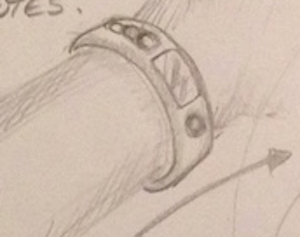
The idea
behind this device is that it helps to support and develop
mindfulness training over a period of time. A convenient and
useful digital counting aid to record and reflect our
progress in mindfulness in everyday life, (or if you’re a
practising buddhist, it will enable you to keep track of
your accumulations for example).
We live in challenging times amidst speed, busyness and
aggression. Depression, stress and anxiety are on the
increase and many doctors are recommending mindfulness
training as an antidote to anxiety, stress and depression.
Problem is, it's not that easy to be mindful for even just
some of the time - try being mindful, present and aware for
just a few minutes, it is more than likely that distractions
of all kind will arise in the mind to take you away from the
present moment! However, as the great spiritual masters tell
us, everything is just practice and its possible for anyone
to develop mindfulness and awareness which in turn is very
good for our mental and emotional health and well-being.
There is a Tibetan Buddhist saying that its a long walk to
the meditation cushion. However, everyday, there are
thousands of moments that offer countless opportunities to
practise mindfulness.
Basic Function:
• A wearable device that is able to count and record moments or
minutes of mindfulness throughout a day. Mindfulness moments
(MM's) to be
counted as single counts on a button, and / or, by pressing
a start and stop point in time, counting minutes.
• A secondary button counter that will automaticall track
the number of prostrations (a foundational Buddhist yoga
practice) or Yoga postures (ie 'Sun Salutations’). The
device allows the practitioner to be fully present in the
practice or movement itself and not be distracted by the
task of counting.
• When the wearer is ready to see how their mindfulness
training is progressing, they will be able to connect the
device to a PC to view their accomplishment in a graphic
display.
Possible future
development (or stretch goal)
A secondary device (at home) which, either by means of light or the
motion of a prayer wheel
reflects back to the wearer, their mindfulness
progress in a visual
way, so as to act as a positive incentive to practice more.
Perhaps the greater the mindfulness, the brighter the
light or rotations of the prayer wheel. I would like this to be powered by solar
energy gathered during
the day on a window sill. When the
primary device (the wrist wearable) is connected
to the secondary device, it could acts as a switch. If the
accomplishment falls within stated
integer values, then the
light shines at a stated brightness; or
the prayer wheel
rotates at a stated
speed for a stated duration.
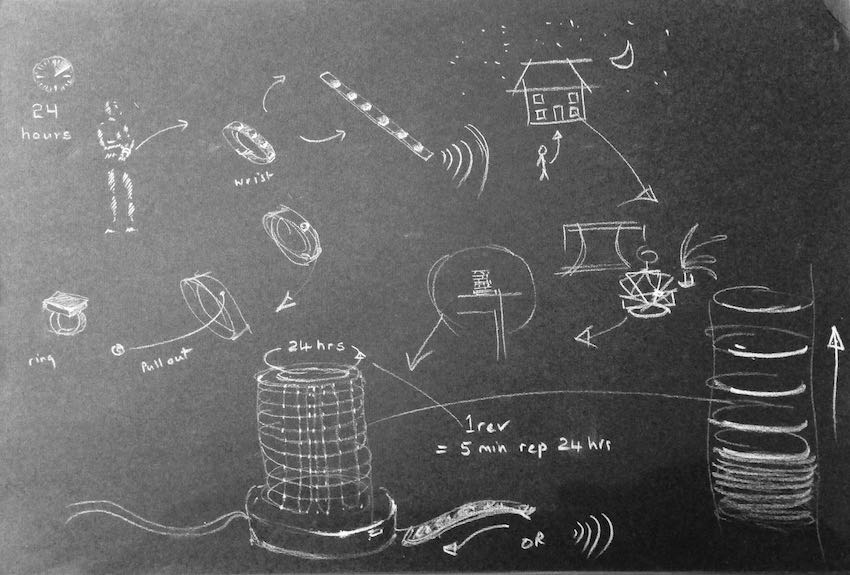
INITIAL
EXPLORATION OF WAYS TO COUNT:
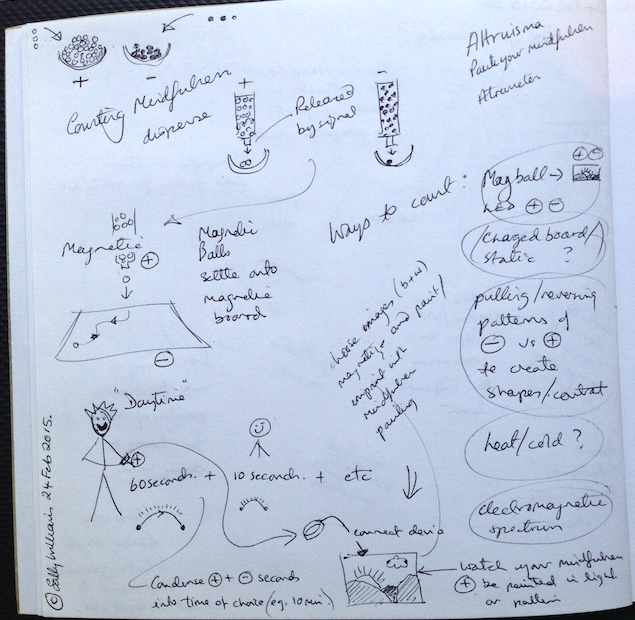
How the
weekly assignments informed my final project
During Embedded Programming (Week 7), the assignment
was to program the board (made in Electronic Design - Week
6). As my final project involved digitally counting and
recording 'moments of mindfulness’ this gave me an insight into how
this could be achieved, as shown in the code
below:
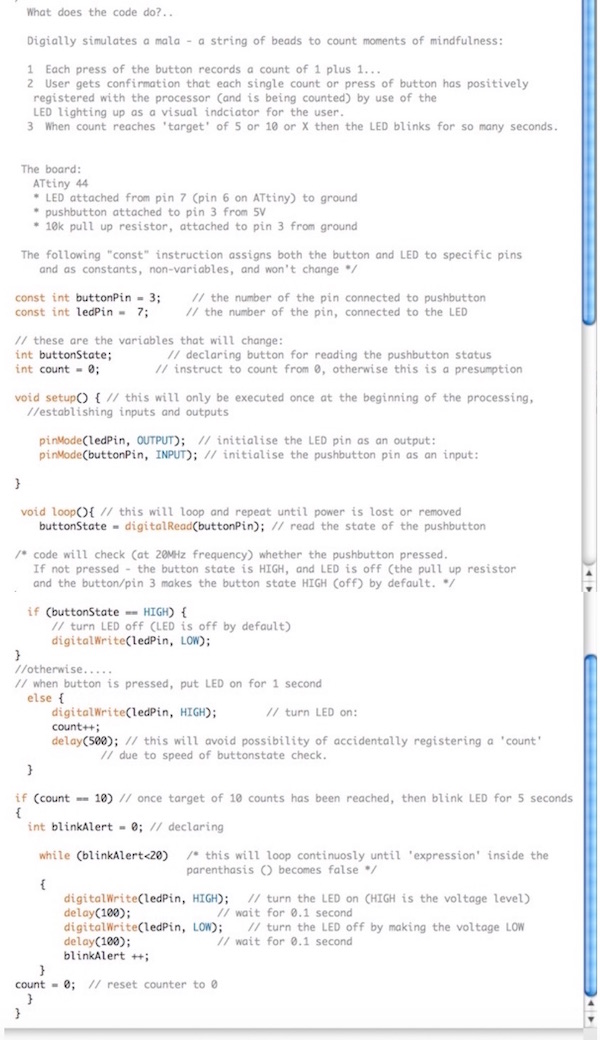
The assignment in Moulding and Casting (Week 9),
would prove to be a significant contribution towards the manufacturing
process for my final project.
The main material for
the digital mala would need to
be:
flexible;
comfortable;
safe to wear on
the skin;
non-corrosive (for the embedded electronics).
For these reasons, silicon rubber was chosen as a likely
material, (which
meant I could
begin to visualise how the device might look and behave).
However, the silicone Rubber used in week 9 was quite
difficult to work with (see pic below); I would seek to find
a product that would be less viscous, and I would need to
refine my casting method.

I had wanted to use Input Device (Week 10) to make a
useful contribution towards my final project.
For my wrist wearable digital mala, I learnt that the use a
phototransistor could be very useful. Using the basic principle that when the
phototransistor
does not receive light, I could programme it to count.
This could provide a semi-automatic counting method whilst
the practitioner practices sun salutations or
prostrations. That
is, when the body lies flat to the ground, there
is an opportunity for the wrist wearable (with embedded phototransistor)
to make contact with the floor, blocking most of the light,
hence counting one.
As this action is repeated, the count accumulates
automatically and effortlessly so that the practitioner is
hinder-free of the task of counting. When a set target is
reached, the device could alert the
wearer via haptic feedback (vibration).
However, in actuality,
it was noted that the phototranistor was very
sensitive to any changes to the ambient light in the room.
This made it more
difficult to establish a reliable light-to-darkness change-range for my particular device. When I
repeated the test at home, the phototransistor was even more
sensitive to ambient light, as there was a flood of light
from a near window. I experimented with pushing blutack
around the PT to block ambient light (simulating an opaque
housing for the phototransistor). Once the body of the PT
was encased in this way, the results were much more stable
and repeatable. However, this first hand experiment urged me
to consider other, more reliable solutions. The image below, show the PT
working in different light settings (and encased in blu
tack).

During Output Device (Week 10), I was able see how I
may be able to program and power a motor. In relation to my
stretch goal project (the secondary device), this technology
could provide the basis for creating a very light prayer
wheel, although I would want to power with photo-voltaic
(solar power).

During assignments in both CAD and Composites Week 3 and
12, there were opportunities to create 3D files (using
Solidworks) to mill on the shopbot milling machine (see
image below - core for bath rest composite). This experience
would help me create the mould for my silicone rubber
wearable.
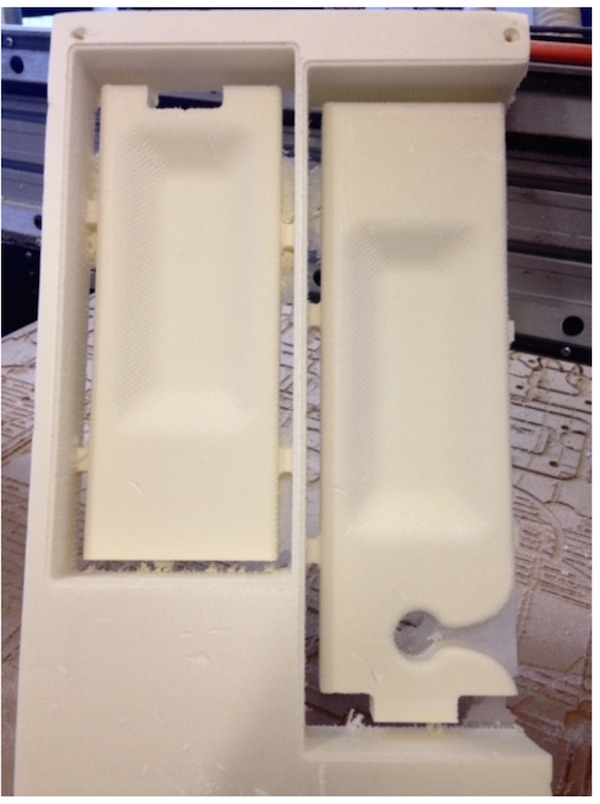
Interface and Application Programming Week (14),
informed a significant part of my final project.
This week provided an opportunity to bring the electronics
and programming to life. In terms of my digital mala
wearable, this is where, potentially, the user would be able
to see their mindfulness accomplishment communicated in a
simple graphic display on a computer screen.
As my wearable was counting and recording data, without the
use of an LCD on the wearable itself, it would require a
means to make sense of the data and communicate effectively
to the user. This week’s assignment helped me to understand
how I could achieve this (with much support from my tutors, as always).
During this week I was able to establish both the basis of
the apps function and the feel of the graphics.
As mindfulness is connected with awareness, spaciousness,
presence and clarity, there is no better metaphor than an
open blue sky. I decided to use a sky blue background, and
to use a timeline divided into a number of small time
intervals (for quick testing). However many times the button
would be pressed in interval (that data would be translated
into a visual representation of moments of mindfulness on
screen; whilst also showing the progress of one's mind
training over a number of intervals (representing a month
for example).
Initial sketch illustrating the concept; app simulating recorded counts from
the electronics to the PC:

For more infomration on my final project, go to FINAL PROJECT here

